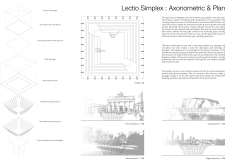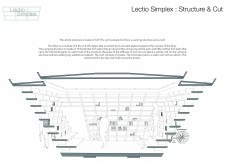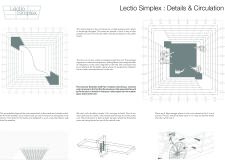5 key facts about this project
Lectio Simplex is a design characterized by its thoughtful integration of space and functionality within a clear and transparent structure. Located in a community-oriented setting, it serves as a multifunctional area that invites users to engage in reading, discussion, and learning. The overall concept aims to create an inviting environment that promotes both individual introspection and social interaction.
Concept and Functionality
The design features a supporting structure that holds a roof covering an atrium, enhancing the usability of the space. The arrangement includes racks for the storage and sharing of books, allowing easy access for users. This layout ensures that light naturally filters into the area, creating a warm and engaging atmosphere that encourages visitors to explore the available reading materials.
Structural Features
Cross-Laminated Timber (CLT) forms the backbone of the structure, offering a strong yet lightweight building solution. Horizontal and vertical elements work together to create a stable framework. The floor is designed with dimensions of 4.35 by 4.35 meters and rests on four concrete plates at its corners, which contribute to the overall stability without adding unnecessary weight.
User Interaction and Accessibility
A central open area promotes movement and interaction among users. This thoughtful design allows for conversation and social engagement, creating a sense of community. The inclusion of bike storage at the uncut corners reflects a consideration for urban mobility while maintaining fluid circulation. Additionally, the cut corners create pathways through the unit, enhancing accessibility and promoting openness between the inside and outside.
Seating arrangements are incorporated into the design, allowing people to face one another comfortably. This promotes discussions and collaborative activities related to reading. Each aspect of Lectio Simplex contributes to a rich experience where users can reflect individually as well as connect with others in their environment.






















































